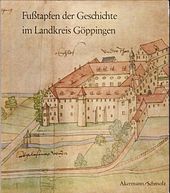Wiesensteig Castle
Wiesensteig Castle is a city palace in Wiesensteig in the Göppingen district . The building, which was built as a four-wing complex in the middle of the 16th century, was demolished in 1812 except for the south wing and today serves as the community center of the city of Wiesensteig.
history
In 1434 a noble seat of the local lords of Wiesensteig was mentioned for the first time in Wiesensteig, which probably served them as a seat until the 15th century. In 1516 the castle became the new seat of the Lords of Helfenstein , who lost their original seat in Geislingen an der Steige in 1396 to Ulm and moved their main residence to Hiltenburg in the Upper Filstal. After the Hiltenburg was destroyed by Duke Ulrich von Württemberg in 1516, their castle in Wiesensteig became the new residence of the Helfensteiners.
In the middle of the 16th century, Count Ulrich XVII. von Helfenstein planned the construction of a new four-wing castle, which was carried out from 1551 to 1555. After a partial collapse of the building, the builder Peter Biller from Kirchheim unter Teck , who had been carrying out the work until then, was dismissed and the building was completed by an unknown builder. Towards the end of the 16th century, external changes were made to the palace, which are still there today. For example, in 1596 a pleasure garden was created near the castle. After the Counts of Helfenstein died out in 1627, the village of Wiesensteig was divided up, so that one third fell to the Princes of Fürstenberg and two thirds to the Electorate of Bavaria . In 1752, Kurbayern was able to acquire a third of the Fürstenberg and set up the Vogt's apartment and official residence in the castle. As a result of the Reichsdeputationshauptschluss 1806, the rule Wiesensteig fell to Württemberg . The castle served as the seat of the Oberamt Wiesensteig until 1810 before it became part of the Oberamt Geislingen .
In 1812 three wings of the unused castle were demolished, only the so-called Fürstenberg wing remained. This was after various uses in the 19th century, u. a. as a fruit box, residential building, doctor's practice or post office, acquired by the city of Wiesensteig and used as a community center after a thorough renovation between 1983 and 1986.
Individual evidence
- ↑ a b c Information from the Wiesensteig community about the castle . Accessed June 23, 2014.
- ^ A b Walter Ziegler [Ed.]: The district of Göppingen. Theiss, Stuttgart, 1985, ISBN 3-8062-0374-1 , p. 160.
- ↑ Dagmar Zimdars [edit.]: Georg Dehio: Handbook of German Art Monuments. Baden-Württemberg I. Deutscher Kunstverlag, Berlin and Munich, 1993, ISBN 3-422-03024-7 , p. 858.
- ^ A b Ziegler [ed.]: The district of Göppingen. P. 161.
- ↑ a b Description of the Oberamt Geislingen. Issued by the Royal Statistical-Topographical Bureau; unchanged new edition of the edition from 1844, Bissinger, Magstadt, 1976, p. 270.
Coordinates: 48 ° 33 '48.2 " N , 9 ° 37' 39.7" E


